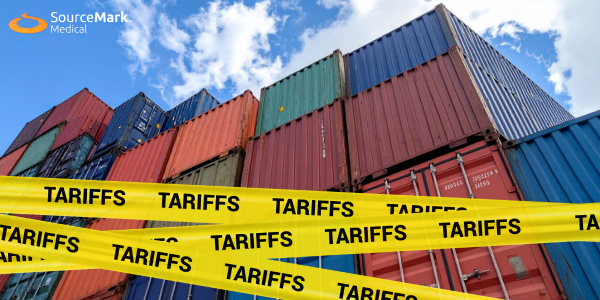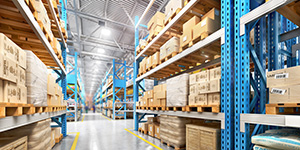
SourceMark’s President and General Counsel, Richard Manson, was recently invited to participate in a Day on the Hill organized by NMSDC for the 3rd year.
In the halls of Washington, tariffs are often debated as a strategic lever of foreign policy—a powerful tool to protect domestic industries and encourage fair trade. The prevailing public narrative, often repeated in sound bites and headlines, is that the burden of these tariffs falls on the exporting country, forcing it to pay a tax on goods entering the U.S. However, for the backbone of the American economy —the millions of small businesses that drive innovation and employment —this couldn’t be further from the truth.
Tariffs are a tax paid directly by the U.S. importer, creating a crippling financial and psychological burden that ripples through the supply chain. This blog post will debunk the myth of who pays, explore the devastating economic and emotional toll on small business owners, and, most importantly, provide a roadmap for not just surviving, but thriving, in an unpredictable trade environment.
The Economic Reality: A Tax on American Businesses
To understand the impact, one must first understand the mechanism. A tariff is a tax collected by U.S. Customs and Border Protection on imported goods and services. It is the American company, not the foreign one, that is legally and financially responsible for this payment. For a small business with a tight budget and limited access to capital, this is a significant and often unexpected expense.
The direct financial impacts are profound. For a company importing even a small portion of its materials, a 15-25% tariff can wipe out entire profit margins. This immediate drain on working capital forces businesses into a reactive stance, delaying critical investments in marketing, technology, or expansion. It can put a hard stop on hiring plans and can even threaten the company’s solvency by straining cash reserves.
The effects are not limited to direct importers. The modern supply chain is a complex web of interconnected businesses. The ripple effect is felt by distributors, wholesalers, and even service providers who rely on imported equipment. As their suppliers are forced to pass along increased costs, a small business finds itself squeezed between rising expenses and a market that is often unwilling to accept corresponding price increases. A UC Davis study on U.S. tariff history found that, far from strengthening businesses, tariffs historically reduced the average size of U.S. firms and made them less productive, as they weakened the incentive to innovate and compete.
Beyond the balance sheet, tariffs also have a significant psychological toll. The uncertainty of ever-changing trade policies can create a state of chronic stress for business owners. This constant worry about a future they cannot control can lead to burnout and distract from the core mission of running and growing the business.
The Disproportionate Effect on Minority-Owned Businesses
The challenges of tariffs are not felt equally across the business landscape. Minority-owned businesses often face a disproportionate burden due to several systemic factors that are exacerbated by sudden shifts in trade policy.
- Existing Access to Capital Gaps: Long-standing disparities in access to financing mean that many minority entrepreneurs lack the deep cash reserves or favorable credit lines that larger, non-minority-owned firms can use to absorb sudden cost increases. When a tariff is imposed, these businesses are less able to “tariff front-run” by stockpiling inventory or absorbing the initial financial shock, forcing them to make difficult decisions much faster.
- Vulnerable Supply Chains: Many minority-owned businesses are concentrated in sectors like retail, beauty supply, and restaurants, which are heavily reliant on imported goods or materials. Their supply chains are often less diversified and less flexible, making it difficult for them to pivot to new suppliers when a tariff is imposed. While a large corporation can leverage its scale to negotiate new terms or shift production, a small, Black-owned apparel brand may not have the luxury of finding a new fabric source on short notice, putting its seasonal inventory at risk.
- Market and Consumer Sensitivity: Many minority-owned businesses serve communities with lower disposable incomes. Raising prices to offset tariff costs is often not a viable option, as it risks alienating a core customer base that is highly sensitive to price fluctuations. This leaves business owners with the untenable choice of either taking a significant profit hit or losing market share to larger competitors who can afford to keep prices stable.
Managing the Conversation: A Masterclass in Transparent Communication
Navigating a price increase with customers is never easy, but in a tariff-driven environment, it becomes an unavoidable necessity. The key is to manage the narrative with honesty, empathy, and a clear focus on value.
- Communicate Early and Honestly: Don’t let a price increase be a surprise. Get ahead of the news with a proactive, transparent message. A well-crafted email from leadership, a post on your blog, or a formal letter to your B2B clients can frame the change as a necessary adjustment. Be specific without being overly political. For example, “Due to rising import and material costs driven by recent trade policies, we are making a necessary price adjustment to maintain our product quality.”
- Tailor Your Message to Your Audience: A B2C customer responds to a different message than a B2B partner.
- For B2C Customers: Focus on the continued quality and integrity of your product. Remind them of what makes your brand special—is it craftsmanship, durability, or a commitment to ethical sourcing? Provide options, such as a “last chance” to purchase at the old price or a coupon for a future purchase, to soften the blow.
- For B2B Partners: Your communication should be more strategic. Provide data and a clear rationale. Show them the specific cost increases and explain how this change is part of a larger strategy to maintain long-term supply chain stability and quality. This positions you as a partner working together to solve a mutual problem.
- Empower Your Front-Line Team: Your sales and customer service teams are on the front lines of these conversations. Equip them with not just a script, but a deep understanding of the situation. Hold a dedicated training session to answer their questions and empower them with an “empathy toolkit” that helps them listen, validate concerns, and steer the conversation back to the value you provide.
Beyond Survival: Turning Adversity into Opportunity
While tariffs are designed to disrupt, they also create a landscape of new possibilities for agile and experienced small businesses. This is where strategic thinking can turn a crisis into a catalyst for growth.
- Strategic Acquisition of Distressed Assets: The financial pressure of tariffs can force smaller, less resilient competitors to close their doors or seek a buyer. This presents a unique opportunity for a financially stable business to acquire a competitor’s customer base, key talent, intellectual property, or specialized assets at a favorable valuation. Due diligence is key. Look for companies with a strong brand but a weak supply chain, or a talented team that lacks the capital to navigate the new trade landscape. This isn’t just a chance to eliminate a rival; it’s a strategic move to consolidate market share and expand your capabilities without the high costs of organic growth.
- The Competitive Advantage of “On-Shoring” and Diversification: Tariffs are making domestic production more economically viable and, in many cases, more reliable. If your business is already a U.S. manufacturer or producer, this is the perfect opportunity to showcase that advantage. Stress that your supply chain is not at the mercy of international trade disputes. This stability is a powerful selling point that can attract customers who are tired of uncertainty and want a local partner they can count on. Similarly, a business that was once heavily reliant on one country for supplies can use tariffs as a forced opportunity to diversify its supply chain, seeking out new partners in untariffed regions.
- Product Innovation through Necessity: Tariffs can force businesses to get creative. When a key imported component becomes prohibitively expensive, companies are driven to find or create a domestic alternative. This constraint-driven innovation can lead to the development of new, superior products or a more efficient and resilient manufacturing process. By investing in research and development, a small business can turn a supply chain challenge into a powerful opportunity to innovate and differentiate itself from the competition.
By the Numbers: The Real Economic Impact of Tariffs
The financial and operational burdens of tariffs are not theoretical; they are backed by concrete data from across the U.S. economy. Recent studies from leading economic think tanks and government agencies provide a clear picture of the costs that have been paid and are projected to be paid by American businesses and consumers.
- Soaring Tariff Rates: After remaining relatively stable for years, the average effective U.S. tariff rate has surged to levels not seen since the 1930s. At its peak in April 2025, the rate reached as high as 27%, and while it has since declined due to trade adjustments, it remains historically elevated at approximately 18%. This stark increase illustrates the immediate and dramatic shift in the cost of imported goods.
- A Tax on the American Household: The burden of these tariffs is being passed down the supply chain directly to consumers. The Budget Lab at Yale estimates that all tariffs implemented in 2025 will increase the overall price level by 1.8% in the short run. This translates to a significant loss of purchasing power for the average American household, equivalent to an estimated $2,400 annually. A survey by the Federal Reserve confirms this trend, finding that approximately 75% of businesses are passing at least some of their tariff-related costs on to customers.
- A Drag on Growth and Employment: The macroeconomic effects are equally concerning. Looking forward, economists project that all 2025 tariffs will lower U.S. real GDP growth by -0.5 percentage points in both 2025 and 2026. In the long run, the U.S. economy is expected to be persistently 0.4% smaller, representing an annual loss of $115 billion. The labor market is also feeling the strain, with projections indicating a decline of approximately 494,000 jobs in payroll employment by the end of 2025.
These numbers underscore a critical reality: tariffs are a regressive tax on American households and a direct financial blow to the small businesses that form the backbone of our country’s economy.









